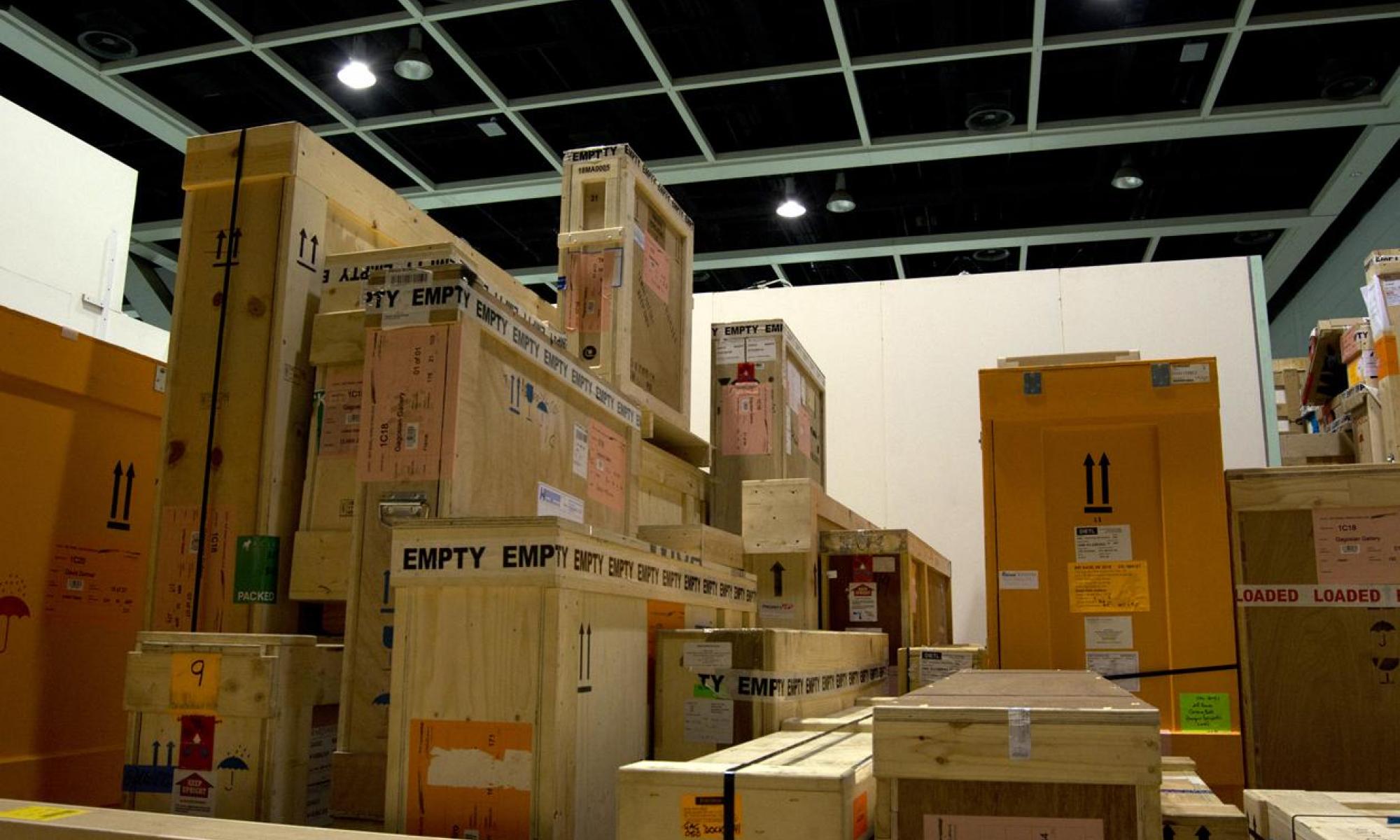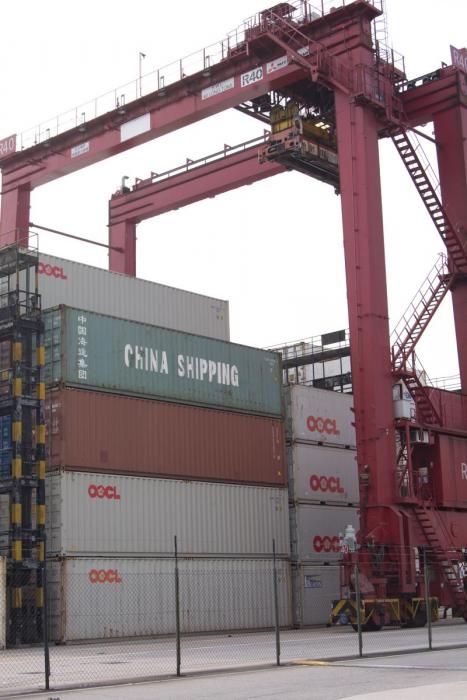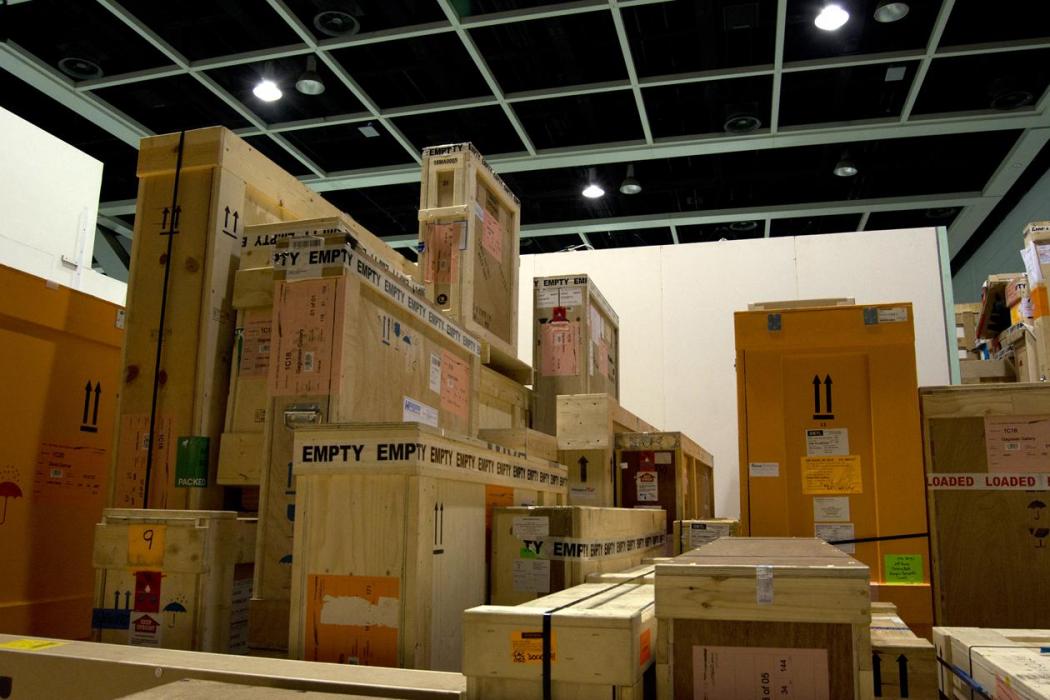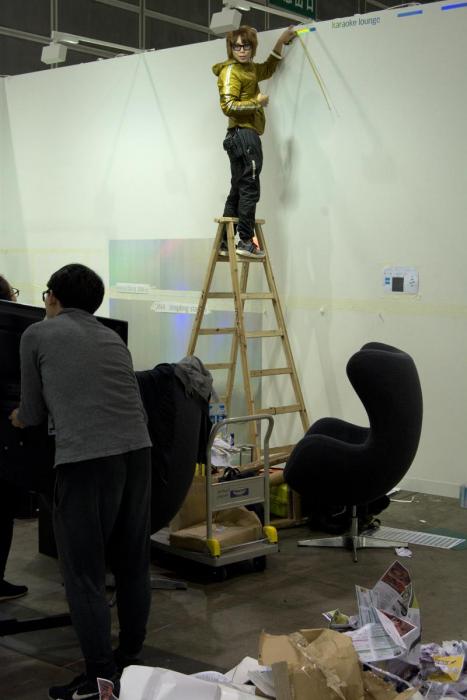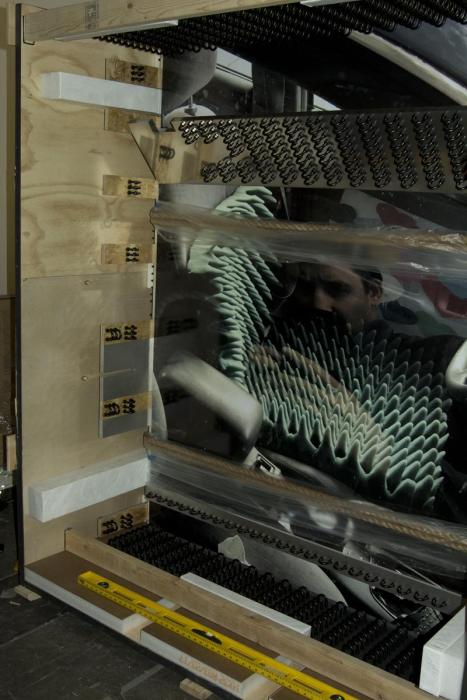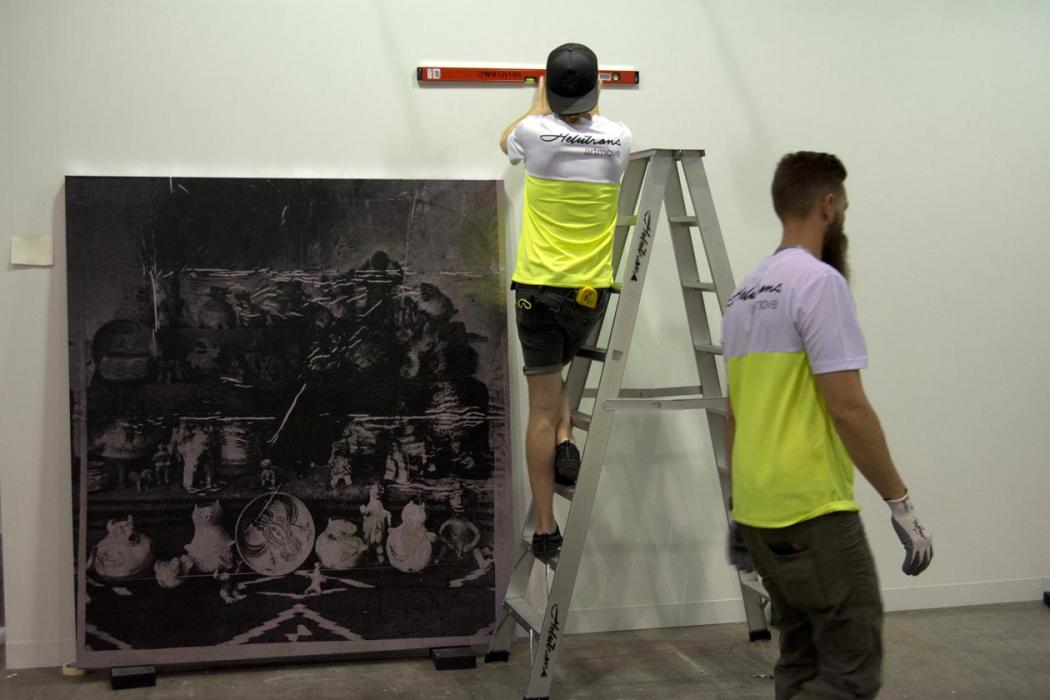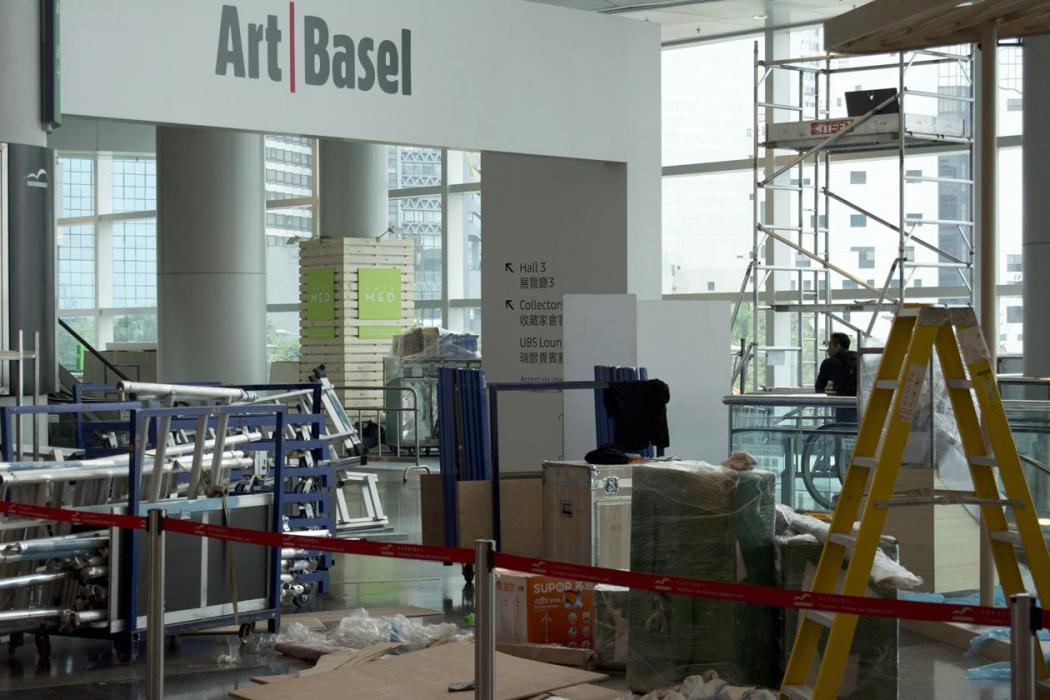Send It All To The Bottom Of The Sea
HONG Kong is an economic gateway to mainland China and one of the busiest ports in the world. Twenty four hours a day the dockside gantry cranes operate, shifting and consolidating containers sitting as high as apartment blocks. Forget towering mountains, glaciers or other natural manifestations of the sublime, this is the true measure of humans and their fleeting lives. People come and go but industry and trade is eternal and never sleeps. It is so fitting that this site is where Art Basel Hong Kong really begins.
Around 70 containers are sitting here stuffed full of art from across the world and worth close to three billion dollars. Soon enough an intricate web of logistical procedures will commence and all of the blood, sweat and art education embodied in hundreds of art pieces will be delivered to the Hong Kong Convention and Exhibition Centre 13 kilometers away. There, on delivery docks nearly 400 meters long, art transport companies such as Helutrans, Dietl and Toll, servicing a global gallery clientele, nervously await their shipments. And as an art handler—just another link in the supply chain—bearing witness here on the loading bay one can easily comprehend the great gulf between the business, pleasure and politics of contemporary art and its labour demands. [1]
For pharaohs to build pyramids, pharaohs need slaves and they are all here waiting to open the containers. This analogy is excessive, since the crew on Art Basel are not actually slaves but paid workers. However the large teams of Chinese, Singaporean, Malay, Indonesian and Filipinos hauling out crates weighing hundreds of kilograms with little else than collective muscle and chanting strikes one as similarly biblical in its fervor. On each box—manhandled on to dollies and forklifts—you can see titles straight out of international art magazines: Gagosian, White Cube, Victoria Miro, Sonnabend, and David Zwirner. Each name distracts and goads the labourers with their unspoken imperatives and they may as well read Khufu, Khafre and Menkaure. [2]
Inside, the teams of art handlers get started on the setting up of 248 exhibition spaces. Many are from Australia, Germany, The United Kingdom, America, Brazil and France and they work with European, Australian and American galleries to unpack assemble and install everything. Occasionally they may have to soothe the nerves of anxious registrars keeping track of their consignments or help confused curators with the final placement of objects.
For the privilege of being here the participating galleries will all be paying over US$50 thousand [3] plus shipping costs and other sundries, so it does not come cheap. But dealers will do whatever it takes because in 2017, 21% of sales in a global art market worth $64 billion were by Chinese investors. [4] And 90% of art imported into China last year was through Hong Kong. [5] Much of it purchased at fairs like Art Basel and its smaller companion further along the harbour at Art Central.
To witness this entire operation come together in the time it does (48 hours) is amazing and the result is a trade spectacle studiously maintaining its affiliation with the various issues, discourses and philosophies circulating about the world of art.
Guest curators like Alexie Glass-Kantor from Art Space Sydney who co-ordinates Encounters and its large scale installations outside of the usual booths, engages audiences by asking: ‘What is it you encounter when you encounter art?’. There is also the Art Basel Conversations series on topics concerning the global contemporary art scene. And the local press is busy providing its readers with its must see lists, who’s hot and what’s not.
While the event runs for five days the first two days are private affairs, exclusive for buyers. It is only by the end of the third day that public ticket holders are let in to experience the ‘transformative power of art’ or similar attractions. The fundamental raison d’être of the Art Basel fair is to serve the super rich and compel investment in predominantly speculative and also blue chip contemporary artists. And through it’s Hong Kong franchise to create inroads into the booming Asian art market.
Its heavy marketing emphasises notable sales such as the $35 million paid for DeKooning’s Untitled XII shown by Lévy Gorvy [6] and its major publication for 2018 is The Art Market; a report prepared by Dr Clare McAndrew in collaboration with the global banking firm UBS. To hope that any artist or their work retains some form of autonomy beyond the investment market such as you may find with a stand-alone gallery or a museum is almost laughable. Critic Jerry Saltz noted in 2005 that fairs are ‘adrenaline-addled spectacles for a kind of buying and selling where intimacy, conviction, patience, and focused looking, not to mention looking again, are essentially nonexistent’. [7]
For the technicians responsible for hanging all this stuff (most of them are very well acquainted with the works they service), they are in a very privileged position in the art worker hierarchy. They tend to have intimate contact with these coveted objects and can take in the event at a pace that is far more measured then that of buyers and public viewers. Nonetheless, for such people art is very quickly emptied of its individuality and simply becomes an array of connections, clips and installation processes. Beautiful canvases by Alex Katz become d-ring to d-ring measurements. A Chien-Chi Chang video piece becomes little more the brand of the data projector, flash drive or USB cables needed to view it or the correct zip ties needed to hold a Conrad Shawcross sculpture together effectively take precedence. Each space, far from being a discreet encapsulation of individual works within it become sections of 10mm particle board needing constant touching up; supporting various weighty items that should not fall down or over but often do.
So it is difficult to not become cynical as an installer and to somehow feel complicit in this metamorphosis of art culture into secret deals done in the collector’s lounge amid the whispering flow of vast amounts of money. And everything art may have stood for in another time and place comes to represent hardly more than items in a trade show on the same level as boats and caravans or hardware at an arms fair. From this perspective a work like Bluebird Planter (From Jeff Koon’s Banality Series 2010-2016) has little meaning beyond that of a Tomahawk missile (although the bird probably has a higher asking price). They might share nothing in common as aesthetic objects but both are traded in cloud of secrecy among a handful of dealers and investors who most people will never encounter in their lives.
In 2000 there were 55 art fairs worldwide. Today there are over 180 with no real sign of leveling off and a near constant movement of artworks across the planet supplying them. Modern transport networks make it so incredibly easy and efficient and one could almost forget that these aren’t mass produced consumables in the same vein as flat screen monitors. But during bump out, among the huge amounts of garbage, empty champagne bottles and discarded catalogues, as you watch the crates being squeezed back into their shipping containers, the uncomfortable feeling keeps coming back that these are nothing more than common goods; subject to the same attrition rates of any freight lapping our post-globalised world. [8]
What’s to say a whole suite of Frank Auerbachs couldn’t be the victim of a rogue wave in the Atlantic? Maybe a Gagosian container could disappear from the docks in London. Or what’s to prevent a Yoshitomo Nara dog after a rough flight, emerging from its box in Miami as an unsalvageable mess? To think such thoughts with a certain amount of it-could-happen glee is positively heretical of course, because in an idealistic sense, art is meant to be looked after so it can remain intact through the ages as cultural relics or important markers of periods in history.
And many art handlers, regarding the works in their care, are indeed idealistic. Many are arts graduates and practice art themselves. So even though having first hand experience of the machinations that go into global art fair, can make one jaded, it’s not just about a wage. Being around such a vast collection of work in one place remains enriching and extraordinary. However if the contemporary art industry is indeed little more than a traveling market distributing magical items of wonder to the one percenters then let such objects go to the bottom of the sea from time to time. After all, every other manufacturing sector has to expect a little breakage and international commercial art fairs are really no different.
[1] I should note here that I have been working as an art handler on this gig for four years now and many of the observations and opinions expressed here stem from first-hand experience.
[2] Khufu, Khafre and Menkaure commissioned the building of the three pyramids of Giza
[3] Julia Halperin, ‘Art Fair Economics: Small galleries Gamble’, Artnet, 13 June 2017, https://news.artnet.com/market/art-fair-economics-small-galleries-gamble... accessed 23 April 2018
[4] Clare McAndrew, ‘The Art Market’, Art/Basel, 2018, https://www.artbasel.com/about/initiatives/the-art-market; accessed 23 April 2018
[5] Sophie Hui, ‘SAR boosts arts with global fair’, The Standard Hong Kong, 28 March 2018, http://www.thestandard.com.hk/section-news.php?id=194227; accessed 23 April 2018
[6] ‘Art Basel Hong Kong 2018: What The Dealers Had To Say’, Artlyst, 31 March 2018, http://www.artlyst.com/news/art-basel-hong-kong-2018-dealers-say/; accessed 23 April 2018
[7] Jerry Saltz, ‘Feeding Frenzy’, The Village Voice, 25 January 2005, https://www.villagevoice.com/2005/01/25/feeding-frenzy-3/; accessed 23 April 2018
[8] Brexit, cancellation of the TPP, simmering trade wars and tariff impositions (China & US), a social media climate that fosters isolation and tribalism and a new cold war developing between east and west are examples of a Post Globalised condition. How this shift influences the character of the international art scene will be for another essay.

